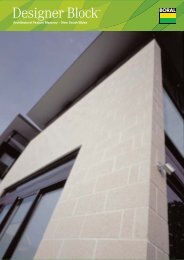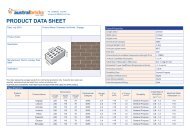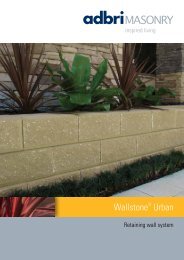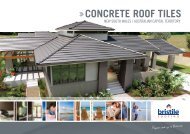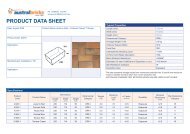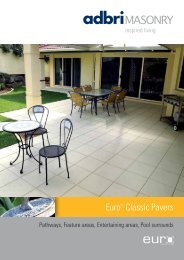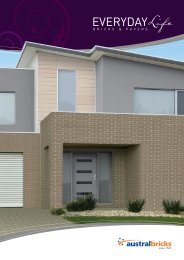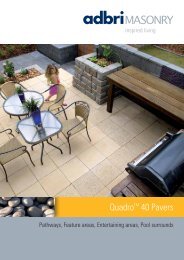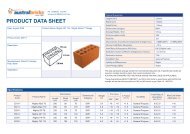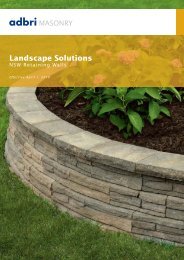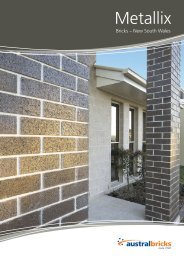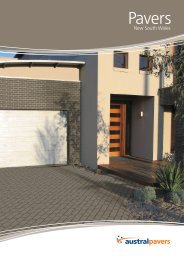Adbri Masonary Brcik and Block Brochure - Shoalhaven Brick and Tile
Adbri Masonary Brcik and Block Brochure - Shoalhaven Brick and Tile
Adbri Masonary Brcik and Block Brochure - Shoalhaven Brick and Tile
Create successful ePaper yourself
Turn your PDF publications into a flip-book with our unique Google optimized e-Paper software.
Technical Information<br />
St<strong>and</strong>ards<br />
All <strong>Adbri</strong> Masonry concrete blockwork is manufactured to AS/NZS4455.1 - Masonry Units<br />
<strong>and</strong> Segmental Pavers <strong>and</strong> tested to AS/NZS4456 - Masonry Units <strong>and</strong> Segmental Pavers/:<br />
Methods of Test. For more information on design <strong>and</strong> construction refer CMAA document MA55.<br />
Fire Resistance<br />
AS3700 - Masonry Structures sets out the method for determining fire resistance of walls<br />
based on test data. It is recommended that designers calculate or check the structural adequacy,<br />
integrity <strong>and</strong> insulation for each wall configuration to ensure conformance to the Building<br />
Code of Australia (BCA). <strong>Adbri</strong> Masonry have an extensive range of bricks <strong>and</strong> blocks<br />
meeting the requirements of the BCA. Refer to the <strong>Adbri</strong> Masonry Fire & Sound brochure<br />
for more information.<br />
Acoustics<br />
The statutory requirements for sound attenuation are set out in Section F5 of the BCA.<br />
The new BCA deemed-to-satisfy provisions increase the levels of airborne sound insulation<br />
<strong>and</strong> apply to wall/floor systems tested in the laboratory. These figures are Rw + Ctr not less<br />
than 50. <strong>Adbri</strong> Masonry have a number of high performance wall systems which have been<br />
developed to accommodate the new stringent requirements imposed by the BCA, to satisfy<br />
all acoustic needs. Refer to the <strong>Adbri</strong> Masonry Fire <strong>and</strong> Sound brochure for more information.<br />
Control Joints<br />
Control joints must be incorporated in masonry as necessary to control <strong>and</strong> limit the<br />
movements referred to in AS3700 clause 2.5.2.2. Control joints should extend the full height<br />
of the wall <strong>and</strong> be spaced 8m centre for concrete units <strong>and</strong> at 6m centre for light weight<br />
units where walls are not interrupted by full height doorways or window openings.<br />
General Guidelines<br />
All concrete blockwork should be laid dry, so covering on site is recommended. Whenever work<br />
is stopped, the tops of walls should be covered to prevent moisture entering the cores of the<br />
blocks <strong>and</strong>/or cavity. All mortar joints should be allowed to set to “thumb print” hardness<br />
before tooling. Brush away excess mortar with a semi stiff brush at the end of each days work.<br />
Cleaning<br />
Care should be taken to keep bricks <strong>and</strong> blocks as clean as possible during laying. There<br />
are various methods of general cleaning from dry brushing, water washing as well as using<br />
chemicals. For a complete listing refer to the CMAA Code MA41. When using a weak acid<br />
mixture it is recommended for cleaning down at no stronger than 1 part acid to 20 parts<br />
water. Walls should be wet thoroughly before application <strong>and</strong> washed thoroughly with water<br />
after application. High water pressure is not recommended. Note: Always trial solution in<br />
a small area which is not highly visible.



